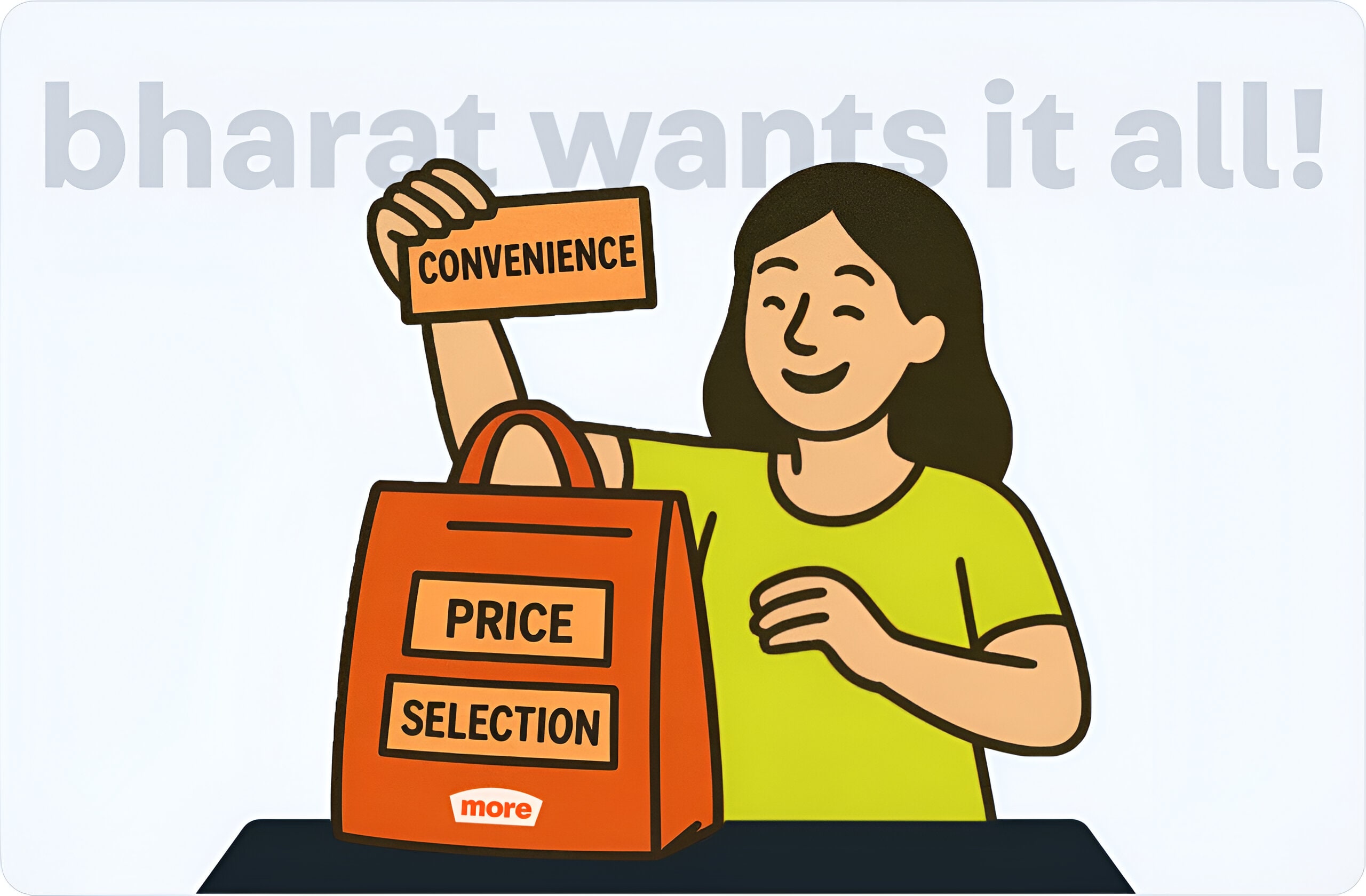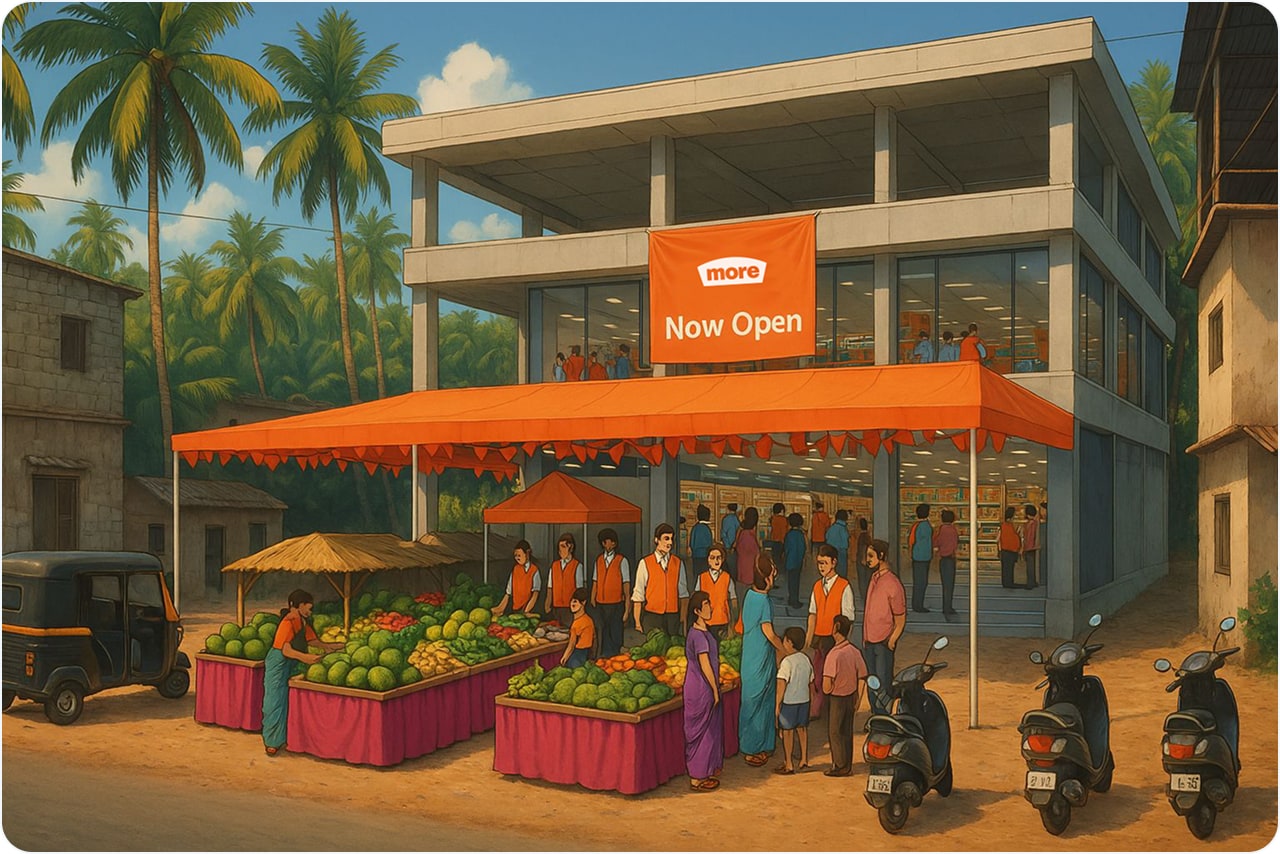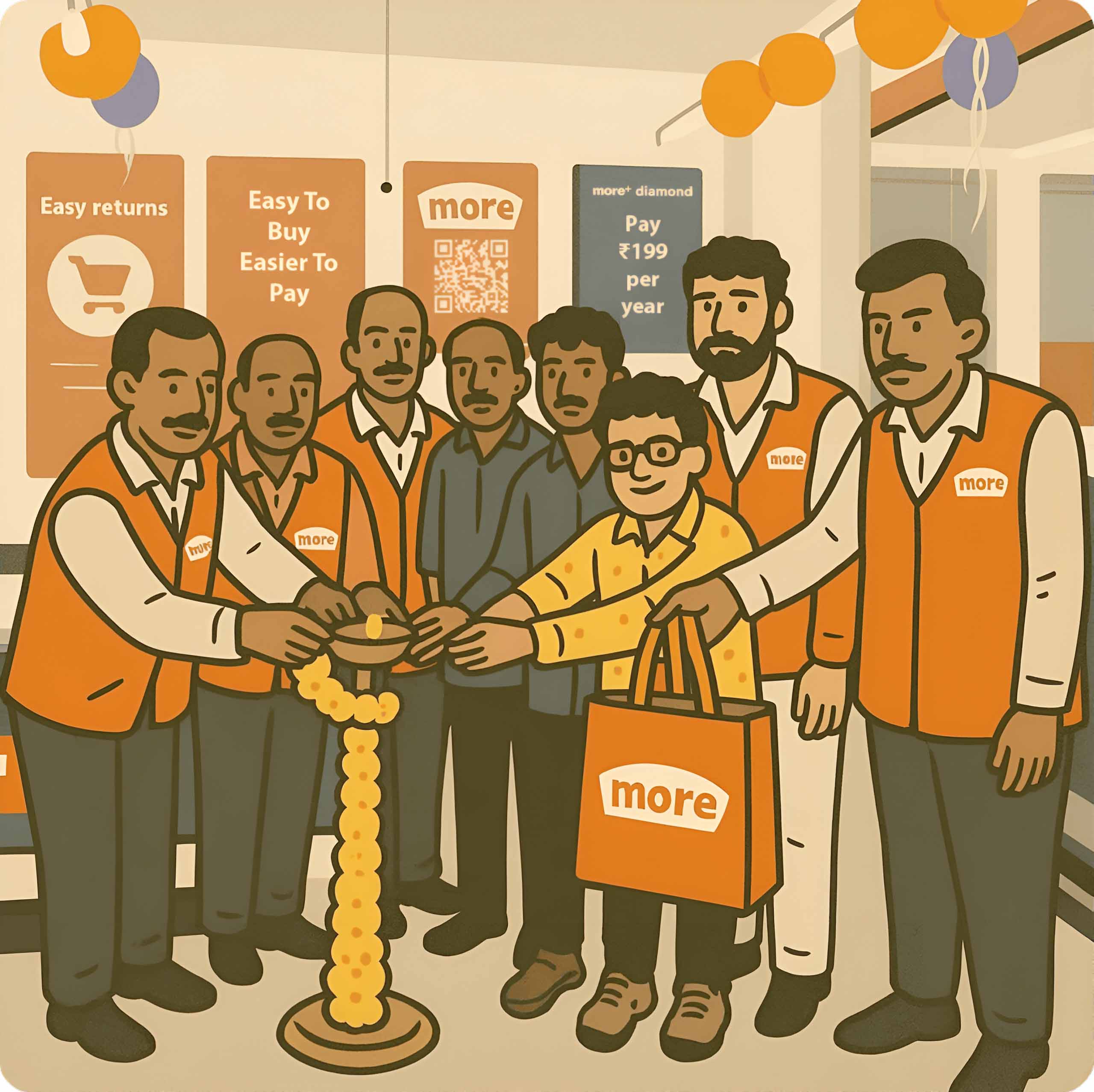The Bharat Opportunity: Beyond the Metros
I’ve spent a lot of time traveling to the smallest towns in India, and one thing is clear: the future of Indian retail lies far beyond our metro cities. We often talk about “Bharat” to mean the India outside the big metros, and Bharat is where the growth is. Consider this: 90% of India’s population and 80% of its GDP are outside the major metros. Metros get most of the attention, but the real opportunity is in the Tier 2, 3, and 4 cities and towns. These are home to the majority of our people, and their aspirations are rising.
The data tells a compelling story. Rural consumption is growing at twice the rate of urban. In Q2, FMCG demand grew around 2.8% in urban areas versus nearly 6% in rural India, a clear indicator that Bharat is outpacing the big cities. What’s more, the signs of increasing affluence in smaller cities are everywhere. For example, credit card companies report that big-ticket credit card spending is growing four times faster in non-metros than in metros. In other words, consumers outside the top cities are rapidly upping their spending and consumption. And digital connectivity is no longer an urban privilege – 71% of urban Indians have a smartphone, and already 41% of rural Indians do. The next wave of online shoppers will come from Bharat, if we can reach them. All these trends reinforce my belief that the next decade of retail growth will be driven by Bharat’s towns and small cities.
Closing the Retail Gap in Small Towns
If the opportunity is so huge, why have consumers in small towns and semi-urban areas been underserved for so long? The truth is, shoppers in Tier 2-4 towns face a very different reality compared to metro consumers. Let me break down the key challenges holding back retail in Bharat:
-
Supply Chain & Infrastructure: Getting goods to remote towns reliably and quickly is hard. Roads and logistics networks outside metros are improving but still not good enough, resulting in patchy supply and stockouts. As a retailer, I feel this every day – the supply chain in smaller towns is still very inefficient. This means the latest products or fresher stock often don’t reach Bharat in time.
-
Limited Choice: Consumers in small towns do not have the variety of choice that we take for granted in big cities. Many shoppers tell me they can’t find their preferred brands or a good range of products locally. The local kirana may carry a very narrow selection. Why should a family in, say, Kumta or Koraput have fewer choices than one in Mumbai? They shouldn’t, and we aim to change that.
-
Poor Shopping Experience: Those of us in metros are used to clean, air-conditioned supermarkets and modern malls. But in many tier 3 and 4 towns, the shopping experience is often subpar. I’ve walked into some stores in smaller towns and found them dimly lit, cramped, and sometimes unhygienic. People have money to spend, but they don’t have an experience they enjoy. This is a huge gap – consumers in Bharat deserve the same quality retail environments as anyone in a metro.
-
Higher Prices for Consumers: It’s ironic that in India, the poorer the town, the more one pays for basics. Due to inefficient supply chains and a lack of competition, prices in small towns can be significantly higher than in metros. A kilo of dal might cost 15-18% more in a tier-3 town than in a big city. This isn’t right – the Bharat consumer should not have to pay a “poverty premium.”

These challenges are exactly what we at More Retail are determined to tackle. The way I see it, our mission is to bridge this retail gap – to bring the same price, selection, and experience advantages of modern retail to every town in India. This is not just about business for us, it’s about making sure a customer in Jharkhand or coastal Karnataka has the same access to quality and value as someone in Delhi or Bangalore.
Unlocking the potential of Bharat: Price, Convenience & Selection
How do we unlock the potential of Bharat’s shoppers? We are going after it by relentlessly focusing on what I call our growth flywheel – Price, Convenience, and Selection. These three elements feed into each other, creating a virtuous cycle of better customer experience and business growth.
-
Affordable Prices: I firmly believe that price is a key lever in Bharat. We aim to be the lowest-priced food and grocery retailer in every neighbourhood we serve. From day one, we’ve worked to remove extra costs from our supply chain and achieve economies of scale, so we can pass on savings to customers. Whether it’s everyday staples or fresh produce, we strive to make it more affordable. When we offer lower prices, we attract more customers, which in turn gives us more scale to keep prices low – that’s the flywheel in action.
-
Superior Convenience & Experience: Convenience in Bharat is about being close to the customer and easy to shop with. Our stores are designed to be within walking distance for the local community, and we ensure they are clean, well-organized, and shopper-friendly – a modern retail experience even in a small town. Additionally, we offer the convenience of online ordering and quick delivery through our partnerships (more on that next). Customers can choose to walk in or order from home, whichever they prefer. By providing a seamless and hygienic shopping experience, we’re turning first-time visitors into regular loyal customers.
-
Wide Selection: The third part of the flywheel is selection – bringing the largest assortment of products to Bharat. Even in a smaller format store, we try to stock a broad range of categories: fresh fruits and vegetables, staples, packaged foods, personal care, home needs, and more. Importantly, through our online integration, our customers get access to an even bigger inventory than any single store could hold. Our goal is to ensure that if a family in a tier-3 town wants something, they can find it at More. By offering more choice, we prevent the need for shoppers to travel to a distant city or settle for a second-best option. Selection drives more footfall and online traffic, which again drives scale and better prices.

This flywheel strategy – offering better prices, greater convenience, and wider selection – has been the cornerstone of More’s growth. It addresses exactly the pain points Bharat shoppers face (high prices, poor access, limited choice) and turns them into our strengths. And underpinning all of this is a strong backbone of technology and supply chain innovation, ensuring we can execute on these promises in every location we enter.
Hybrid Omnichannel: The More Model
One of the things I’m most proud of is how we’ve pioneered a hybrid omnichannel model that blends the best of offline and online retail for Bharat. We are neither just an offline retailer nor purely an e-commerce player – we are a hybrid that combines the trust and touch of local stores with the limitless reach of online shopping. What does this hybrid model look like on the ground? It starts with our network of local stores. We set up a physical More supermarket in a town – that’s the anchor. Customers can walk in, see and touch the products, talk to our staff, and buy things in a traditional way. But that same store is also a hub for digital orders. Through our partnership with Amazon, when customers in that area order groceries on Amazon Fresh, the order is fulfilled by the nearest More store. Our store staff pick and pack the items, and an Amazon delivery partner brings it to the customer’s doorstep, often within a couple of hours.
In effect, each store doubles up as a micro-fulfillment center for online orders. This gives us a huge advantage: we can enter a new city with an offline store, establish our brand and supply chain locally, and then quickly scale up online deliveries in that city without building separate warehouses. It’s highly efficient. We call our stores in such areas “hybrid stores” because they serve both walk-in shoppers and online customers. Over time, as online demand in a city grows, we can even set up “dark stores” – stocking points that cater only to online orders – to further boost capacity. For example, Cochin (Kochi) in Kerala started with a couple of More supermarkets a few years ago. Later, we connected those stores to Amazon, turning Cochin into a hybrid online+offline market. Next month, Cochin will even get a dark store to handle surging online orders. It’s a great case of how a city can evolve in our model from purely offline to a true omni-market.
Another recent example is Kumta, a small coastal town in Karnataka. We just launched a new More store in Kumta a short while ago, bringing modern retail to that town for the first time. The excitement from the local community was incredible – finally, a supermarket with fresh produce and good prices right in their hometown! And we’re not stopping there: within the next 90 days, we plan to “open” Amazon in Kumta as well, meaning Kumta’s residents will be able to order from More on the Amazon app for home delivery. This “offline-first, online-follow” approach is how we unlock Bharat. We enter a town, establish the More brand and trust locally with a store, and quickly follow up by offering the convenience of online shopping in partnership with Amazon. It’s a powerful one-two punch.

Our store in Kumta reflects the perfect blend of Modern Trade in Bharat
The hybrid model allows us to scale fast without compromising profitability. We don’t have to build an expensive warehouse in every small city – our store is the warehouse. We also save on customer acquisition because our physical store itself is the best advertisement and onboarding channel for online users (people see our Amazon branding in-store and give it a try, or vice versa). This way, we keep our costs low and our reach high, which is crucial for serving Bharat’s value-conscious consumers. At the end of the day, whether a customer shops by walking into a More store or by tapping their phone, it’s the same More experience and great value. That’s the More advantage.
Building Stores that Transform Communities
Each new More store we open in a Tier 3 or 4 town instantly becomes the best store in that town. I say that with pride because I’ve seen how locals react. When we opened a store in a small town in Orissa, customers walked in and couldn’t believe the variety under one roof – many of them had never had a modern grocery store in their area. We become not just a retailer, but a local champion in those communities, creating jobs, partnering with local suppliers (for example, sourcing fresh produce from nearby farmers), and giving families a better shopping option than traveling to a faraway city. And through our Amazon tie-up, even people who live 20-30 km away from our store can shop with us online if we cover their area for delivery. The ripple effect is huge.

Of course, expanding into Bharat’s heartland is not without challenges – each region has its preferences, languages, and quirks. We take a hyper-local approach, customizing our store assortment to local tastes (be it the specific snacks people like in Orissa or the brand of rice preferred in Jharkhand). Our local teams engage with the community, and we often hire staff from the town itself – so that our store feels by the locals, for the locals. This helps us integrate quickly and gain trust in new markets.
Tracking Our Impact
While our vision and strategy are compelling, what truly matters are the tangible results we're achieving. Our Net Promoter Score (NPS) – a powerful measure of customer loyalty and satisfaction which provides a clear picture of how we're resonating with the heart of Bharat. From March 2024 to March 2025, we've witnessed a transformative leap – our NPS soaring from 54 to 71, a testament to our unwavering commitment to the communities we serve.
Net Promoter Score isn't just a metric, it's a direct line of communication from our customers, a pulse check on how deeply we're resonating with the aspirations of Bharat. When we started this journey, we had a vision - to bring selection, convenience, and genuine value to every corner of our market. Our rising NPS is proof that we're not just meeting expectations – we're reshaping them. Each point of NPS represents real people in Bharat – customers experiencing better shopping, trust, more choices, and and the potential of what we can achieve.
Reaching New Heights
Standing today, I feel a sense of optimism and clarity about where we’re headed. We’re building on very strong fundamentals – a large existing base of stores and customers, a proven omnichannel playbook, and a passionate team that believes in our mission. Our goal is clear: to deepen our presence, expand our reach, and continue delivering exceptional value to our customers. We have already grown to 767 stores across 350+ cities and towns, serving about 25 lakh customers each month.
Our expansion roadmap is clear and incredibly exciting. In the near term, by 2026, we aim to grow our footprint by over 40%, adding between 150 and 180 stores. This strategic expansion is a crucial stepping stone towards our larger vision.
Looking ahead to 2030, we aim to reach about 1,700 stores (from 767 now), establishing our presence in eleven hundred towns and cities across India. Just writing that number – 1,100 towns – gives me goosebumps. That’s a big leap, but I’m confident because we have a solid plan to get there: by scaling our store network, deepening our presence in Bharat, and continuously improving our price, convenience, and selection flywheel.
We are operating with the agility of a startup and the foundation of a ₹5,000 crore business. That means we’re fast and adaptable, but also disciplined in execution. One thing I always emphasize is that growth for us must be profitable and sustainable. We’re not chasing expansion blindly; we are ensuring each store can break even quickly and contribute to the bottom line. Our hybrid model helps a lot in this regard – it keeps costs down and revenue streams diversified. I often tell my team that success in retail comes from doing the basics right: managing inventory and costs well. If we continue to do that, while staying laser-focused on the Bharat opportunity, nothing can stop us.
It’s amazing to think that organized retail still accounts for only ~17% of India’s grocery market. That number will grow dramatically, and we intend to be at the forefront of that expansion. The future of organized retail in India is exceptionally bright, and our aim is to lead the charge in bringing its benefits to every last mile. I’m convinced that More Retail will lead the transformation of retail in India, bringing better experiences, wider selection, and lower prices to consumers across Bharat. The true potential of Bharat’s retail story is just beginning to be unlocked – and we at More are proud to be writing the next chapter.
Thank you for reading. I’m excited about the journey ahead and grateful to everyone who’s part of this mission to serve Bharat. Together, let’s go “beyond metros” and make modern retail accessible to all.

Vinod Nambiar
MD & CEO, More Retail
